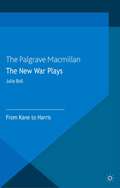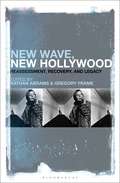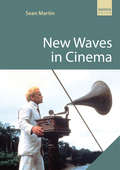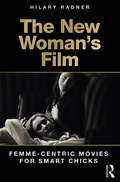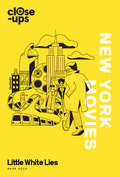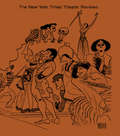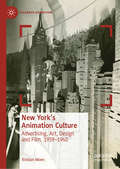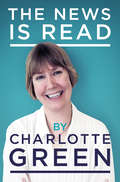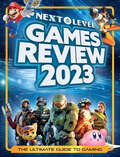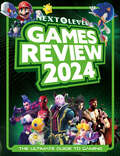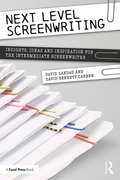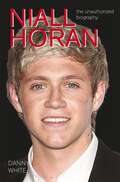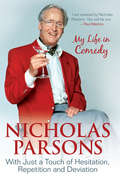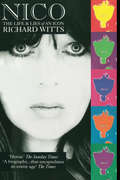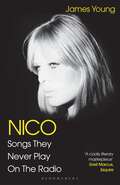- Table View
- List View
The New War Plays: From Kane to Harris
by J. BollHow can war be represented on stage? How does the theatre examine the structures leading to violence and war and explore their transformation of societies? Springing from the discussion about 'New Wars' in the age of globalisation, this interdisciplinary study demonstrates how these 'New Wars' bring forth new plays about war.
The New Wave Cinema in Iran: A Critical Study
by Parviz JahedThe New Wave Cinema in Iran is a historical and analytical study of the Iranian New Wave Cinema (Mowj-e No) as an artistic and intellectual movement that came to its best early productions between 1958 and 1978. As the movement has a long history, Parviz Jahed focuses on the development and the early progression of the movement in the 1960s and explores its emergence and development in the context of the cultural and social conditions of Iran during this period.Jahed first defines the term 'New Wave' in Iran's film culture, in order to identify the root elements that gave traction to this movement. He analyses the degree to which different elements and factors have contributed to the formation of this cinema, accounting for the different approaches of Iranian intellectual filmmakers towards modernity and a modern form of cinema in Iran. The book finishes by studying the works of three intellectual figures and influential filmmakers of the 1960s, Ebrahim Golestan, Farrokh Ghaffari, and Feraydoon Rahnama, who are arguably considered the forerunners of the New Wave Cinema in Iran.
The New Wave Cinema in Iran: A Critical Study
by Parviz JahedThe New Wave Cinema in Iran is a historical and analytical study of the Iranian New Wave Cinema (Mowj-e No) as an artistic and intellectual movement that came to its best early productions between 1958 and 1978. As the movement has a long history, Parviz Jahed focuses on the development and the early progression of the movement in the 1960s and explores its emergence and development in the context of the cultural and social conditions of Iran during this period.Jahed first defines the term 'New Wave' in Iran's film culture, in order to identify the root elements that gave traction to this movement. He analyses the degree to which different elements and factors have contributed to the formation of this cinema, accounting for the different approaches of Iranian intellectual filmmakers towards modernity and a modern form of cinema in Iran. The book finishes by studying the works of three intellectual figures and influential filmmakers of the 1960s, Ebrahim Golestan, Farrokh Ghaffari, and Feraydoon Rahnama, who are arguably considered the forerunners of the New Wave Cinema in Iran.
New Wave, New Hollywood: Reassessment, Recovery, and Legacy
by Nathan Abrams and Gregory FrameAs a period of film history, The American New Wave (ordinarily understood as beginning in 1967 and ending in 1980) remains a preoccupation for scholars and audiences alike. In traditional accounts, it is considered to be bookended by two periods of conservatism, and viewed as a (brief) period of explosive creativity within the Hollywood system. From Bonnie and Clyde to Heaven's Gate, it produced films that continue to be watched, discussed, analysed and poured over.It has, however, also become rigidly defined as a cinema of director-auteurs who made a number of aesthetically and politically significant films. This has led to marginalization and exclusion of many important artists and filmmakers, as well as a temporal rigidity about what and who is considered part of the 'New Wave proper'. This collection seeks to reinvigorate debate around this area of film history. It also looks in part to demonstrate the legacy of aesthetic experimentation and political radicalism after 1980 as part of the 'legacy' of the New Wave. Thanks to important new work that questions received scholarly wisdom, reveals previously marginalised filmmakers (and the films they made), considers new genres, personnel, and films under the banner of 'New Wave, New Hollywood', and reevaluates the traditional approaches and perspectives on the films that have enjoyed most critical attention, New Wave, New Hollywood: Reassessment, Recovery, Legacy looks to begin a new discussion about Hollywood cinema after 1967.
New Wave, New Hollywood: Reassessment, Recovery, and Legacy
As a period of film history, The American New Wave (ordinarily understood as beginning in 1967 and ending in 1980) remains a preoccupation for scholars and audiences alike. In traditional accounts, it is considered to be bookended by two periods of conservatism, and viewed as a (brief) period of explosive creativity within the Hollywood system. From Bonnie and Clyde to Heaven's Gate, it produced films that continue to be watched, discussed, analysed and poured over.It has, however, also become rigidly defined as a cinema of director-auteurs who made a number of aesthetically and politically significant films. This has led to marginalization and exclusion of many important artists and filmmakers, as well as a temporal rigidity about what and who is considered part of the 'New Wave proper'. This collection seeks to reinvigorate debate around this area of film history. It also looks in part to demonstrate the legacy of aesthetic experimentation and political radicalism after 1980 as part of the 'legacy' of the New Wave. Thanks to important new work that questions received scholarly wisdom, reveals previously marginalised filmmakers (and the films they made), considers new genres, personnel, and films under the banner of 'New Wave, New Hollywood', and reevaluates the traditional approaches and perspectives on the films that have enjoyed most critical attention, New Wave, New Hollywood: Reassessment, Recovery, Legacy looks to begin a new discussion about Hollywood cinema after 1967.
New Waves in Cinema
by Sean MartinThe term 'New Wave' conjures up images of Paris in the early 1960s: Jean Seberg and Jean Paul Belmondo, the young Jean-Pierre Leaud, the three protagonists of Jules and Jim capering across a bridge, all from the films of French filmmakers Jean-Luc Godard and François Truffaut. The impact of the French New Wave continues to be felt, and its ethos of shooting in real places, with non-professional actors and small crews would influence filmmakers as diverse as John Cassavetes and Martin Scorsese to Lars von Trier's Dogme 95 movement, all of whom sought to challenge the dominance of traditional Hollywood methods of both filmmaking and storytelling. But the French were not the only new wave, and they were not even the first. In New Waves in Cinema, Sean Martin explores the history of the many New Waves that have appeared since the birth of cinema, including their great forebears the German Expressionists, the Soviet Formalists and the Italian Neorealists. In addition, Martin looks at the movements traditionally seen as the French New Wave's contemporaries and heirs, such as the Czech New Wave, the British New Wave, the New German Cinema, the Hollywood Movie Brats and Brazilian Cinema Novo. The book also covers other new waves, such as those of Greece, Hungary, documentary - Cinema Verité and Direct Cinema - animation, avant garde and the so-called No Wave filmmakers. New Waves in Cinema also explores the differences - and similarities - between the concept of a 'new wave' and a national cinema, citing, among others, the example of the new Iranian cinema, which has given us directors as important as Abbas Kiarostami and the Makhmalbaf family, examines resurgent trends in the national cinemas of Mexico, Japan, American independent cinema and concludes with an examination of the most celebrated movement of the 1990s and 2000s, Dogme 95. New Waves in Cinema makes a convincing case for the necessity for the continued existence of new waves and national cinemas in the face of Hollywood and American cultural imperialism.
The New Woman's Film: Femme-centric Movies for Smart Chicks
by Hilary RadnerWith the chick flick arguably in decline, film scholars may well ask: what has become of the woman’s film? Little attention has been paid to the proliferation of films, often from the independent sector, that do not sit comfortably in either the category of popular culture or that of high art––films that are perhaps the corollary of the middle-brow novel, or "smart-chick flicks". This book seeks to fill this void by focusing on the steady stream of films about and for women that emerge out of independent American and European cinema, and that are designed to address an international female audience. The new woman's film as a genre includes narratives with strong ties to the woman’s film of classical Hollywood while constituting a new distinctive cycle of female-centered films that in many ways continue the project of second-wave feminism, albeit in a modified form. Topics addressed include: The Bridges of Madison County (Clint Eastwood, 1995); the feature-length films of Nicole Holofcener, 1996-2013; the film roles of Tilda Swinton; Rachel Getting Married (Jonathan Demme, 2008); Blue Jasmine (Woody Allen, 2013); Frances Ha (Noah Baumbach, 2012), Belle (Amma Asante, 2013), Fifty Shades of Grey (Sam Taylor-Johnson, 2015) and Jane Campion’s Top of the Lake (Sundance Channel, 2013-).
The New Woman's Film: Femme-centric Movies for Smart Chicks
by Hilary RadnerWith the chick flick arguably in decline, film scholars may well ask: what has become of the woman’s film? Little attention has been paid to the proliferation of films, often from the independent sector, that do not sit comfortably in either the category of popular culture or that of high art––films that are perhaps the corollary of the middle-brow novel, or "smart-chick flicks". This book seeks to fill this void by focusing on the steady stream of films about and for women that emerge out of independent American and European cinema, and that are designed to address an international female audience. The new woman's film as a genre includes narratives with strong ties to the woman’s film of classical Hollywood while constituting a new distinctive cycle of female-centered films that in many ways continue the project of second-wave feminism, albeit in a modified form. Topics addressed include: The Bridges of Madison County (Clint Eastwood, 1995); the feature-length films of Nicole Holofcener, 1996-2013; the film roles of Tilda Swinton; Rachel Getting Married (Jonathan Demme, 2008); Blue Jasmine (Woody Allen, 2013); Frances Ha (Noah Baumbach, 2012), Belle (Amma Asante, 2013), Fifty Shades of Grey (Sam Taylor-Johnson, 2015) and Jane Campion’s Top of the Lake (Sundance Channel, 2013-).
New York City and the Hollywood Musical: Dancing in the Streets (Screening Spaces)
by Martha ShearerIn examining the relationship between the spectacular, iconic and vibrant New York of the musical and the off-screen history and geography of the real city—this book explores how the city shaped the genre and equally how the genre shaped representations of the city. Shearer argues that while the musical was for many years a prime vehicle for the idealization of urban density, the transformation New York underwent after World War II constituted a major challenge to its representation. Including analysis of 42nd Street, Swing Time, Cover Girl, On the Town, The Band Wagon, Guys and Dolls, West Side Story and many other classic and little-known musicals—this book is an innovative study of the relationship between cinema and urban space.
New York Movies (Close-Ups #3)
by Mark Asch Little White LiesThe indispensable, illustrated pocket guide to New York movies, from Martin Scorsese and Woody Allen to Lena Dunham and Noah Baumbach. ALSO AVAILABLE: Close-Ups: Wes Anderson Close-Ups: Vampire Movies
The New York Times Theater Reviews 1997-1998
by C. S. SmithFirst published in 2001. Routledge is an imprint of Taylor & Francis, an informa company.
The New York Times Theater Reviews 1997-1998
by C. S. SmithFirst published in 2001. Routledge is an imprint of Taylor & Francis, an informa company.
New York's Animation Culture: Advertising, Art, Design and Film, 1939–1940 (Palgrave Animation)
by Kristian MoenThis book reveals and explores the thriving animation culture in midtown Manhattan, the World’s Fair, art galleries and cinemas during a vibrant period of artistic, commercial and industrial activity in New York City. Alongside a detailed investigation of animated film at the time – ranging from the abstract works of Mary Ellen Bute and Norman McLaren to the exhibition practices of the Disney Studios and the New York World’s Fair – New York’s Animation Culture examines a host of other animated forms, including moving dioramas, illuminated billboards, industrial displays, gallery exhibitions, mobile murals, and shop windows. In this innovative microhistory of animation, Moen combines the study of art, culture, design and film to offer a fine-grained account of an especially lively animation culture that was seen as creating new media, expanding the cinema experience, giving expression to utopian dreams of modernity, and presenting dynamic visions of a kinetic future.
The News Is Read
by Charlotte GreenFor twenty-seven years Charlotte Green was one of the most iconic newsreaders on Radio 4. Her rich, velvety voice was a staple on the radio and a treat for millions of listeners. Charlotte joined the BBC in 1978 and became one of the regular readers on the Today programme, where her voice proved to be a reassuring constant in the midst of momentous occasions and terrible tragedies alike - her bulletins have covered everything from the fall of the Berlin Wall in 1989 to the 7/7 London bombings in 2005. After leaving Radio 4 in 2013, Charlotte joined Classic FM, where she now presents an arts and culture programme, Charlotte Green's Culture Club. In this highly entertaining and touching autobiography, Charlotte tells the story of the woman behind the voice, with all the endearing qualities that have delighted her listeners for years and gained her various prestigious accolades. The News is Read is a must-have for anyone wanting to spend a few hours in the company of this warm, charming and wonderfully modest woman whose writing is as engaging as her voice.
Next Level Games Review 2023
by Expanse Ben WilsonTake it to the next level! Bursting with the biggest games, latest trends, and hottest news, Next Level Games Review 2023 is the ultimate annual gaming guide.
Next Level Games Review 2024
by ExpanseTake it to the next level! Bursting with the biggest games, latest trends, and hottest news, Next Level Games Review 2024 is the ultimate annual gaming guide.
Next Level Screenwriting: Insights, Ideas and Inspiration for the Intermediate Screenwriter
by David Landau David Bennett CarrenNext Level Screenwriting is an intermediate screenwriting book, for those that have already learned the basics of screenwriting, written a screenplay or two and want to bring their writing and stories to the next level. Each chapter of the book examines a specific aspect of screenwriting, such as character, dialogue and theme, and then provides the reader with ideas, tips and inspiration to apply to their own writing. Rather than being another “how to” book, this volume features a variety of case studies and challenging exercises throughout – derived from a broad selection of successful feature films and TV shows from the 1940s to the present day – to help spark the imagination of the writer as they work through different styles and approaches of screenwriting. An absolute must-read for any screenwriter wanting to improve their writing and storytelling skills.
Niall Horan: The Unauthorized Biography
by Danny WhiteWith One Direction, Niall has sold over 14 million singles and 8 million albums. Their records have topped charts in more than sixteen countries, they have won two BRIT awards and and three MTV Video Music Awards, embarked on sell-out concert tours, and become a business empire with an estimated value of $50m. Niall's personal wealth is estimated at £5m. Niall Horan: The Unauthorized Biography is the story of how a short, smalltown Irish boy shot to overnight national and then global fame. Born in Mullingar, County Westmeath, Niall's early years were difficult as he and his older brother endured the breakdown of their parents' marriage and subsequent divorce. Living between each of his parents' home for the next few years before eventually settling with his father, it was in this period that Niall embarked upon his remarkable musical journey. Stints in the school choir and performances around his homeland, including in support of Lloyd Daniels in Dublin, propelled him to The X Factor and his first brushes with fame. Nothing could have prepared Niall for the adulation and success that followed. Written by Danny White, the author of the Sunday Times bestseller 1D: The One Direction Story, the book reveals how Niall quickly transformed to become as popular as leading light Harry Styles.
The Nice and Accurate Good Omens TV Companion: Your Guide To Armageddon And The Series Based On The Bestselling Novel By Terry Pratchett And Neil Gaiman
by Matt WhymanThe ultimate TV companion book to Good Omens, a massive new television launch on Amazon Prime Video and the BBC, written and show-run by Neil Gaiman and adapted from the internationally beloved novel by Terry Pratchett and Neil Gaiman. '[It was] absurdly good fun...Terry charged Neil with getting it made, almost as his deathbed wish, so it's a real labour of love' - David TennantIn the beginning there was a book written by Terry Pratchett and Neil Gaiman about the forces of good and evil coming together to prevent the apocalypse, scheduled to happen on a Saturday just after tea. Now, that internationally beloved novel has been transformed into six hour-long episodes of some of the most creative and ambitious television ever made. Written and show-run by Neil Gaiman and directed by Douglas Mackinnon, this BBC Studios creation brings Good Omens spectacularly to life, through a cast that includes David Tennant, Michael Sheen, Jon Hamm, Miranda Richardson, Josie Lawrence, Derek Jacobi, Nick Offerman, Jack Whitehall and Adria Arjona. Keep calm, because The Nice and Accurate Good Omens TV Companion is your ultimate guide to navigating Armageddon. Through character profiles and in-depth interviews with the stars and the crew, stunning behind-the-scenes and stills photography of the cast and locations, and a fascinating insight into costume boards and set designs, you will discover the feats of creativity and mind-boggling techniques that have gone into bringing an angel, a demon, and the Antichrist to the screens of people everywhere. This book will take you inside the world of Heaven and Hell (and Tadfield) and is set to shatter coffee tables around the world.
Nicholas Parsons: My Life in Comedy
by Nicholas ParsonsNicholas Parsons has enjoyed a long and varied career encompassing theatre, television, film and radio. He is perhaps best known as the straight man to Arthur Haynes in the '60s, as the presenter of Sale of the Century in the '70s and today as the chairman of the long-running Radio 4 panel game Just a Minute.Along the way, he has performed impersonations in the lavatories of a Clydebank engineering yard during the war, been the voice of a Gerry Anderson Texan sheriff, roller-skated in Charlie Girl at the Victoria Palace and appeared in a series of Doctor Who. His comedy chat show at the Edinburgh Festival Fringe is now in its tenth consecutive year.Here he recalls an extraordinary career that has led him to star on the West End stage, work with some of Britain's finest comedians, including Kenneth Williams, Tony Hancock, Benny Hill and Paul Merton, and appear in stockings and suspenders in The Rocky Horror Show.Funny, thoughtful and at times moving, Nicholas Parsons: With Just a Touch of Hesitation, Repetition and Deviation celebrates a fascinating life in comedy.
Nico: The Life And Lies Of An Icon
by Richard WittsNico was revered as ‘the most beautiful creature who ever lived’. She was Andy Warhol’s femme fatale and the High Preistess of Weird, yet few knew her real name or her wretched origins. When she called herself ‘a Nazi anarchist junkie’, they thought she was joking.Bob Dylan wrote a song about her, Jim Morrison a poem, Jean Baudrillard an essay, Andy Warhol a film, Ernest Hemingway a story – yet she fought against the idolatry of men to assert her independence as a composer of dissident songs.Nico’s contribution as an artist (17 films and 7 LPs) was smothered by gossip of her alleged affairs with men and women, whether Jimi Hendrix or Jeanne Moreau, Brian Jones of the Rolling Stones or Coco Chanel.She drifted through society like a phantom. Each era celebrated a different Nico – the top covergirl of the Fifties, the Siren of the Sixties (as The Times acclaimed her), the Moon Goddess of the Seventies, and the High Priestess of Punk when rock stars like Siouxsie Sioux and Pattie Smith acknowledged her pre-eminence. Ironically, they did so at the lowest point in her life. For behind the Garbo-esque veneer lived a lonely woman trying to stand autonomous in a fast-changing world, seeking to survive her heroin addiction and to cope with her tormented mother and her troubled son, his existence denied by his film-star father.In this pioneer biography, which Nico asked the author to write shortly before her outlandish death in 1988, Richard Witts uncovers the reasons for her subterfuge, and examines the facts surrounding her encounters with terrorist Andreas Baader, the Black Panthers, and the Society for Cutting Up Men. Exclusive contributions from artists such as Jackson Browne, Iggy Pop, Viva, John Cale, David Bailey, Siouxsie Sioux – and many others including her relatives, friends and enemies – make this the definitive biography of an icon who was not only a testament to an era but hitherto unrecognised influence on popular music and style.
Nico, Songs They Never Play on the Radio: Songs They Never Play On The Radio
by James YoungThe story of Nico, former model, film actress, singer with the Velvet Underground and darling of Andy Warhol's factory.;In 1982 Nico was living in Manchester, alone and interested only in feeding her heroin habit. Local promoter Dr Demetrius saw an opportunity, hired musicians to back her, rented a decrepit van and set off with Nico and the band on a disastrous tour of Italy. Over the next six years, until her death in 1988, Nico toured the world with assorted thrown-together bands. They made next to no money, appalled many of their audiences and occasionally, on the rare nights when the music worked, pleased a few.;James Young played keyboards for Nico throughout those years. In this book, he records the never-ending antics of a picaresque circus of addicts, outsiders and misfits who travelled the world - East and Western Europe, the United States, Australia and Japan - encountering an equally bizarre and extraordinary mixture of people: poets, artists, gangsters, losers and drifters. John Cale, John Cooper Clarke, Allen Ginsberg and Gregory Corso are among those who appear in this story of Nico, the last Bohemian.
Nicole Kidman (Film Stars)
by Pam CookPam Cook's study of the star persona of Nicole Kidman traces Kidman's career trajectory through an examination of her (sometimes controversial) film choices and places her in the context of a globalised media and celebrity culture.
Nicole Kidman (Film Stars)
by NA NAPam Cook's study of the star persona of Nicole Kidman traces Kidman's career trajectory through an examination of her (sometimes controversial) film choices and places her in the context of a globalised media and celebrity culture.
Nietzsche's Dancers: Isadora Duncan, Martha Graham, and the Revaluation of Christian Values
by K. LaMotheThis book investigates the role Nietzsche's dance images play in his project of "revaluing all values" alongside the religious rhetoric and subject matter evident in the work of Isadora Duncan and Martha Graham, who found justification and guidance in Nietzsche's texts for developing dance as a medium of religious expression.
